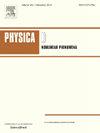耦合野口输电线引起的高阶罗格波信号动力学
IF 2.7
3区 数学
Q1 MATHEMATICS, APPLIED
引用次数: 0
摘要
本文从理论上和数值上研究了电感与电容串联的野口电传输线的横向耦合特性。利用半离散极限下的约化摄动方法,导出了控制系统行为的二维三次五次非线性Schrödinger方程。通过广义达布变换,我们得到了包括一阶、二阶和三阶在内的高阶异常波的解。此外,通过调制不稳定性分析的解析预测表明,该晶格可以支持包络-包络、包络-空穴、空穴-包络和空穴-空穴等多种孤子对。异常波和孤子都可以根据它们的频率向前或向后传播。对异常波信号在系统中的传播特性的研究表明,异常波信号的宽度和速度取决于网络参数和波数以及造成五次效应的实参数。最后,我们的结果表明,网络可以采取双右手或复合右手和左手的行为。本文章由计算机程序翻译,如有差异,请以英文原文为准。
Dynamics of the higher-order-rogue-wave signals due to a coupled Noguchi electrical transmission line
We are theoretically and numerically studying the behavior of a transversely coupled Noguchi electric transmission line with a series connection of linear inductor and capacitor. Using the reductive perturbation method in the semi-discrete limit, we derive a 2D-cubic-quintic nonlinear Schrödinger equation governing the behavior of the system. Performing the generalized Darboux transformation we find higher-order rogue waves including first-, second- and third-one as solutions. Moreover, analytic predictions through Modulational Instability analysis show that the lattice can support a variety of pairs of solitons including envelope-envelope, envelope-hole, hole-envelope and hole–hole. Both rogue waves and soliton can propagate in forward or backward direction according to their frequencies. The study of the propagation properties of the rogue wave signals through the system shows that their width and velocity depend on the network parameters and wavenumbers as well as the real parameter responsible for the quintic effects. Finally, our results reveal that the network can adopt a dual right-handed or a composite right- and left-handed behavior.
求助全文
通过发布文献求助,成功后即可免费获取论文全文。
去求助
来源期刊

Physica D: Nonlinear Phenomena
物理-物理:数学物理
CiteScore
7.30
自引率
7.50%
发文量
213
审稿时长
65 days
期刊介绍:
Physica D (Nonlinear Phenomena) publishes research and review articles reporting on experimental and theoretical works, techniques and ideas that advance the understanding of nonlinear phenomena. Topics encompass wave motion in physical, chemical and biological systems; physical or biological phenomena governed by nonlinear field equations, including hydrodynamics and turbulence; pattern formation and cooperative phenomena; instability, bifurcations, chaos, and space-time disorder; integrable/Hamiltonian systems; asymptotic analysis and, more generally, mathematical methods for nonlinear systems.
 求助内容:
求助内容: 应助结果提醒方式:
应助结果提醒方式:


